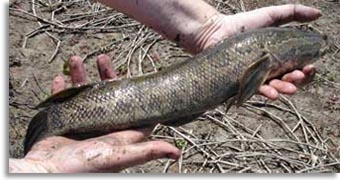|
April 30, 2008
Brinkley, AR – Arkansas Game and Fish Commission fisheries biologists confirmed
a breeding population of northern snakehead, an invasive species from Asia,
in Lee County on April 28.
The population was discovered when a farmer found an unusual fish wiggling
along a gravel farm road near a ditch and contacted the AGFC regional
office in Brinkley. AGFC Fisheries Management Biologist Lee Holt identified
the fish as the invasive species that recently made national headlines.
Since the confirmation, fisheries biologists have worked to establish how
far the population has spread and to control the population.

The species was banned in Arkansas in 2002 and placed under a federal
importation ban the same year because of its potential to cause problems
with native fish. However, biologists believe the species may have been
brought to Arkansas before these regulations were passed.
“The northern snakehead is used as a food species in Asia, and we know some
were brought to fish farms in the U.S. before 2002,” said AGFC Assistant
Chief of Fisheries Mark Oliver. “Fish farmers in Arkansas realized the
potential danger the species posed and tried to eradicate them even before
bans were imposed.”
AGFC biologists are killing every snakehead they find in their research,
but they’re not optimistic that they can eradicate the population.
“We can’t be sure exactly where this population came from and we just don’t
know how far they’ve spread,” added Oliver. “Their abilities to live in
extremely poor water conditions and reproduce quickly make them a difficult
target to completely eliminate.”
John Odenkirk with the Virginia Department of Game and Inland Fisheries has
worked with the species since its discovery in the Potomac River in 2004.
He said the fish are harmless to people, contrary to their vicious
reputation.
“The fish’s name, appearance and ability to survive out of the water for
short periods make it easy to sensationalize. They’re nothing like the
horror stories I’ve heard and seen.”
Oliver agreed, “They’re a top-shelf predator in our fisheries, but they
aren’t some kind of Frankenfish that will attack people or chase them on
land. (AGFC Fisheries biologists) handled quite a few of them in the last
few days, and no one has had any sort of injury or bite.”
The largest fear biologists have concerning the species is its impact on
native fish such as largemouth bass, bream and crappie. Snakeheads are very
aggressive predators, attacking food species as well as fish their own
size.
“Right now it’s just too early to tell what sort of impact snakeheads may
have on a fishery,” said Odenkirk. “But invasive species rarely provide
many benefits to systems where they are introduced. By the time the damage
is seen, it can be too late to control.”
Oliver said that the sooner the AGFC knows about a population of invasive
species, the better the chances for controlling their spread.
If you catch a snakehead or find one in your area, please immediately
contact the AGFC Regional Office in Brinkley, (877) 734-4581, or the
Fisheries Division in the Little Rock Office, (501) 223-6428. Commission
regulations prohibit the import, transport or possession of snakeheads in
Arkansas, however snakeheads caught may be immediately turned in to the
AGFC.
|